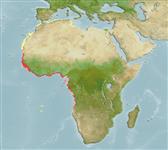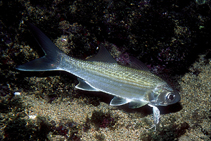Galeoides decadactylus (Bloch, 1795)
Lesser African threadfin
Add your observation in Fish Watcher
| Native range | All suitable habitat | Point map | Year 2050 |

|
| This map was computer-generated and has not yet been reviewed. |
| Galeoides decadactylus AquaMaps Data sources: GBIF OBIS |
Upload your photos and videos
Pictures | Stamps, coins, misc. | Google imageGaleoides decadactylus
Picture by Wirtz, P.
Pictures | Stamps, coins, misc. | Google imageGaleoides decadactylus
Picture by Wirtz, P.
Sierra Leone country information
Common names:
Shinenose
Occurrence: native
Salinity: brackish
Abundance: | Ref:
Importance: | Ref:
Aquaculture: | Ref:
Regulations: | Ref:
Uses: no uses
Comments:
National Checklist:
Country Information: https://www.cia.gov/library/publications/resources/the-world-factbook/geos/sl.html
National Fisheries Authority:
Occurrences: Occurrences Point map
Main Ref: Kamara, A.B., 1977
National Database:
Occurrence: native
Salinity: brackish
Abundance: | Ref:
Importance: | Ref:
Aquaculture: | Ref:
Regulations: | Ref:
Uses: no uses
Comments:
National Checklist:
Country Information: https://www.cia.gov/library/publications/resources/the-world-factbook/geos/sl.html
National Fisheries Authority:
Occurrences: Occurrences Point map
Main Ref: Kamara, A.B., 1977
National Database:
Common names from other countries
Classification / Names Nombres comunes | Sinónimos | Catalog of Fishes(Género, Especie) | ITIS | CoL | WoRMS | Cloffa
> Carangaria/misc (Various families in series Carangaria) > Polynemidae (Threadfins)
Etymology: Galeoides: Greek, galeos = a shark + suffix oides = similar to (Ref. 45335).
More on author: Bloch.
Etymology: Galeoides: Greek, galeos = a shark + suffix oides = similar to (Ref. 45335).
More on author: Bloch.
Environment: milieu / climate zone / depth range / distribution range Ecología
marino; salobre demersal; rango de profundidad 10 - 70 m (Ref. 10799). Subtropical; 37°N - 27°S, 19°W - 16°E (Ref. 57343)
Distribución Países | Áreas FAO | Ecosistemas | Ocurrencias, apariciones | Point map | Introducciones | Faunafri
Eastern Atlantic: West African coasts, from Canary Islands and Morocco to Angola (Ref. 57402). Sporadically known from Algeria and Namibia (Ref. 57343). Record from Mauritius is likely to be erroneous.
Length at first maturity / Tamaño / Peso / Age
Maturity: Lm 11.6 range ? - ? cm
Max length : 50.0 cm TL macho / no sexado; (Ref. 5377); common length : 30.0 cm TL macho / no sexado; (Ref. 3659)
Max length : 50.0 cm TL macho / no sexado; (Ref. 5377); common length : 30.0 cm TL macho / no sexado; (Ref. 3659)
Short description Claves de identificación | Morfología | Morfometría
Espinas dorsales (total) : 9; Radios blandos dorsales (total) : 13 - 14. Diagnosis: 9-10 short detached pectoral filaments, not exceeding length of upper pectoral fin; body moderately elongate and compressed, its height comprised 2.9-3.4 times in standard length; snout very short, blunt and prominent; mouth inferior; posterior edge of maxillary only slightly expanded, barely reaching past eye; 2 widely separated dorsal fins, 1st with 8 spines, 2nd with 1 flexible spine and 13-14 soft rays; 2nd
dorsal fin and anal fin bases barely equal; pectoral fin inserted low on body; scales ctenoid; head and unpaired fins partly covered with small scales (Ref. 57402).
Coloration: body uniformly silvery, upper part greyish and belly white; a large rounded black spot, about equal to eye diameter, generally visible under lateral line, behind opercle (Ref. 57402).
Occurs over sandy (Ref. 2683) and muddy bottoms in shallow waters (Ref. 4340), frequently in brackish habitats (Ref. 4340, 57402) and estuaries, but not in freshwaters (Ref. 57402). Feeds on benthic invertebrates (Ref. 5377). Sold fresh, dried salted or smoked (Ref. 36127).
Life cycle and mating behavior Madurez | Reproducción | Puesta | Huevos | Fecundidad | Larva
Also Ref. 32209.
Main reference
Upload your references | Referencias | Coordinador | Colaboradores
Daget, J. and J.C. Njock, 1986. Polynemidae. p. 352-354. In J. Daget, J.-P. Gosse and D.F.E. Thys van den Audenaerde (eds.) Check-list of the freshwater fishes of Africa (CLOFFA). ISNB, Brussels; MRAC, Tervuren; and ORSTOM, Paris. Vol. 2. (Ref. 4340)
IUCN Red List Status (Ref. 130435: Version 2024-2)
Near Threatened (NT) ; Date assessed: 15 July 2014
Threat to humans
Harmless
Human uses
Pesquerías: comercial
FAO(pesquerías: producción, species profile; publication : search) | FIRMS (Stock assessments) | FishSource | Sea Around Us
Más información
Trophic ecology
componentes alimenticios
Composición de la dieta
consumo de alimento
Food rations
Despredadores
componentes alimenticios
Composición de la dieta
consumo de alimento
Food rations
Despredadores
Population dynamics
Coeficiente del crecimiento para
Max. ages / sizes
Length-weight rel.
Length-length rel.
Length-frequencies
Mass conversion
Reclutamiento
Abundancia
Coeficiente del crecimiento para
Max. ages / sizes
Length-weight rel.
Length-length rel.
Length-frequencies
Mass conversion
Reclutamiento
Abundancia
Life cycle
Reproducción
Madurez
Fecundidad
Puesta
Spawning aggregations
Huevos
Egg development
Larva
Dinámica larvaria
Reproducción
Madurez
Fecundidad
Puesta
Spawning aggregations
Huevos
Egg development
Larva
Dinámica larvaria
Anatomy
Superficie branquial
Brain
Otolith
Superficie branquial
Brain
Otolith
Physiology
Body composition
Nutrients
Consumo del oxígeno
Tipo de natación
Velocidad de natación
Visual pigments
Fish sound
Diseases & Parasites
Toxicity (LC50s)
Body composition
Nutrients
Consumo del oxígeno
Tipo de natación
Velocidad de natación
Visual pigments
Fish sound
Diseases & Parasites
Toxicity (LC50s)
Genetics
Genética
Heterozygosity
heritabilidad
Genética
Heterozygosity
heritabilidad
Human related
Aquaculture systems
Perfiles de acuicultura
Razas
Ciguatera cases
Stamps, coins, misc.
Aquaculture systems
Perfiles de acuicultura
Razas
Ciguatera cases
Stamps, coins, misc.
Herramientas
E-book | Guía de campo | Claves de identificación | Asistente para frecuencias de tallas | Herramienta de ciclo de vida | Mapa de puntos | Classification Tree
| Catch-MSY |
Special reports
Download XML
Fuentes de Internet
Aquatic Commons | BHL | Cloffa | Websites from users | Check FishWatcher | CISTI | Catalog of Fishes(Género, Especie) | DiscoverLife | ECOTOX | Faunafri | Fishtrace | GenBank(genome, nucleotide) | GloBI | GOBASE | | Google Books | Google Scholar | Google | IGFA World Record | MitoFish | Bases de datos nacionales | Otolith Atlas of Taiwan Fishes | PubMed | Reef Life Survey | Scirus | SeaLifeBase | Árbol de la vida | Wikipedia(Go, búsqueda) | World Records Freshwater Fishing | Expediente Zoológico
Estimates based on models
Preferred temperature (Ref. 115969): 20.1 - 27.9, mean 25.9 (based on 66 cells).
Phylogenetic diversity index (Ref. 82804): PD50 = 1.0000 [Uniqueness, from 0.5 = low to 2.0 = high].
Bayesian length-weight: a=0.00851 (0.00542 - 0.01337), b=3.11 (2.98 - 3.24), in cm Total Length, based on LWR estimates for this species & (Sub)family-body (Ref. 93245).
Nivel trófico (Ref. 69278): 3.6 ±0.67 se; based on food items.
Resiliencia (Ref. 120179): Medio, población duplicada en un tiempo mínimo de 1.4-4.4 años (K=0.14-0.4).
Prior r = 0.49, 95% CL = 0.32 - 0.73, Based on 2 data-limited stock assessments.
Fishing Vulnerability (Ref. 59153): Low to moderate vulnerability (30 of 100).
Climate Vulnerability (Ref. 125649): Very high vulnerability (77 of 100).




